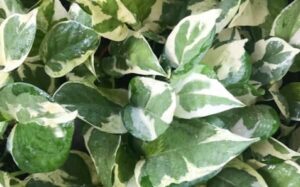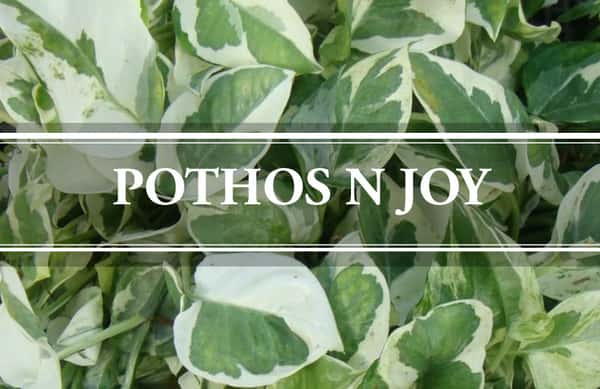Say Cheers to another beautiful Aroid vine, the Pothos N Joy! Besides many other cultivars, this one too comes from the Marble Queen Pothos with various variations in the name. The oval waxy dark-green leaves with white to cream variegation make it look one of its kind.
This plant can get about 10 feet tall and is a nice option for both indoor and outdoor plantations. Be it in pots with some supporting pole or the hanging baskets, your N Joy Pothos will surely be a treat to the eyes. And to your surprise, you don’t need to have any green thumb to enjoy this beautiful trailer.
Want to know more? Keep reading to enjoy an informative read about the care and maintenance of the Pothos N Joy Plant.
Pothos N Joy Classification
Family: Araceae
Genus: Epipremnum
Species: E. aureum
Cultivar: N-Joy
Genus Epipremnum:
This genus of flowering Aroids hails from the tropical forests from China, Southeast Asia to Australia the western Pacific. These evergreen perennial climbers grow around the hosts with the help of their aerial roots.
These plants have a close resemblance with other genera of the tribe Monstereae. Moreover, they are associated with several common names. These names include Centipede tongavine, pothos, and devil’s ivy.
Features of the Pothos N joy Plant

Size:
The size of the vine depends upon the availability of growing space. It can get about 6 to 10 inches in pots. However, in spacious areas, it can even trail up to 10 feet. The trailing stems form roots upon coming in contact with the soil.
Leaves:
The waxy oval-shaped leaves can get about 3 to 6 inches in size on maturity.
Toxicity:
The foliage of all the Pothos plants is toxic for humans and animals. Close contact can lead to skin allergies. Also, ingestion is quite harmful leading to vomiting and ulceration in the throat and mouth. So, make sure you are keeping pets and pets away from the plant.
N joy Pothos Care
N joy plant is an easy-to-care plant. Even the beginners and the lazy peeps can enjoy this vine without putting in much effort.
Quick Guide:
Water: Low to average.
Sunlight: Bright Indirect sun.
Humidity: Average to high.
Fertilizer: Low feeders.
Let us have a deeper look at the care and requirements of the plant.
Water Requirements
Pothos usually need very little water to survive. Moreover, they are highly vulnerable to overwatering and root rot. So, don’t water again until the upper 2 inches of the soil get dry. Make sure you don’t let the plant dry out completely. Water the soil right after the upper layer gets dry.
The watering frequency of the plants varies according to the features like sunlight, weather, and temperature. In summer, about once or thrice is enough for the whole week, depending upon the temperature.
In fall and winter, plants usually consume lesser water. So, reduce the watering up to once every two weeks to three weeks according to the severity of the cold.
Sunlight Requirements
Keep your Pothos N joy plant in bright indirect sun to partial shade. Light availability also affects the appearance of the leaves. In bright light, the white variegation increases. On the other hand, the plant kept in shade for a longer duration may get green without any variegation at all.
The plant is adaptive to fluorescent light as well. This makes it a nice choice for indoor plantations. However, direct sun can scorch out the waxy leaves. So, make sure the plant stays away from long exposures to direct sunlight.
Soil Requirements
Well-drained potting mixtures are suitable for your N Joy Pothos. Outdoor peeps will be good with the natural well-draining soil of the area. On the other hand, you can use a common house plant mix for indoor potting.
If you opt towards a self-mixed product, equal mixtures of peat and perlite show good results.
Temperature Requirements
These dwellers of tropical rainforests like to stay moderately warm. A temperature between 65 to 85° F is ideal for most of the Epipremnum plants.
An important part of the N joy Pothos Care is its intolerance towards cold and frost. A temperature below 55°F is severe enough to freeze or even kill the plant. So, make sure you keep them at some warm indoor place, especially in winter.
Humidity Requirements
Your N Joy Plant loves to stay in high humidity levels. So, maintaining the humidity level to about 70% and above shows good results in terms of healthy foliage. However, it would be fine enough in average and low humidity levels as well.
Fertilizer Requirement
Pothos N Joy plants are low feeders and can survive without fertilizer. However, monthly doses of balanced houseplant fertilizer in spring and summer show good results. Make sure you always use mild concentration, preferably half of the stated dose.
The nutritional requirements of the plants naturally decrease with a low temperature in fall and winter. Thus, never fertilize after the end of the summer season.
Pot Requirements
These trailing plants need support to climb and love to trail down a hanging basket. Outdoors they will climb upon some nearby tree or wall. However, in a potted plantation, you need to provide a supporting pole.
Drainage of the soil/growing mixture is the topmost priority. So, make sure the pot or the basket has drainage holes at the base.
Re-potting Requirement
The plant likes to stay neither root bound nor pot bound. So, repotting is required once the plant gets pot bound with no further space to grow in the pot. Also, it may get root bound and you see roots protruding out from the drainage holes. According to an estimate, you may need to repot after every year or two.
Wilting of the leaves is another possible sign of a root-bound plant. If the leaves are getting yellow and wilting, you need to check your watering routine. If the ‘water issue’ is ruled out, then your plant must need a bigger pot.
Just loosen the soil and take the root ball out. Be very gentle and careful as you don’t want to damage the roots. The new pot will be just a size bigger than the previous with a fresh potting mixture.
Pruning Requirements
Removing the damaged and unhealthy leaves always gives great benefits to the plant. Prune mildly to see better health and appearance of your Pothos and joy plant.
Growth Zones
The plant grows outdoor throughout the year in zones 10 and 11.
Pothos N Joy Propagation
Since these plants bloom rarely, the most common method of propagation is by stem cuttings.
Season:
Spring and summer are generally suitable for propagation. However, the days between the mid of both of these seasons are ideal to propagate the cuttings successfully.
Method:
- Select a healthy plant and get some cuttings with your desired variegation. Make sure there are at least 4 leaves and a node on each cutting. These nodes are the points where the roots will develop from.
- Plant these cuttings in well-draining soil or potting mixture. Water the soil mildly and mist it once or thrice every week to keep it moist. Place the set up in some warm spots and indirect sun.
- Wait for about a week or two and the roots will start developing pretty soon.
Water Propagation:
You can also plant these cuttings in a jar of water. Just make sure you change the water every week to avoid contamination. You can convert these plantlets to the soil as well. However, the roots should not be wet while planting into the soil.
Precautions:
Toxic plants can give you skin allergies. So, don’t forget to wear gloves while handling and propagating.
Related Posts:
Summary
Pothos N Joy is an Aroid cultivar, botanically known as the Epipremnum aureum ‘N Joy’. The vine has oval dark-green leaves with prominent white to off-white variegation. It may get as tall as ten feet and need support to climb upon. This easy-to-care plant needs indirect light, humidity, and watering after the soil gets dry.
Just like other members of the genus, the plant is toxic. Hence, keep kids and pets away from your N Joy Pothos. Besides, don’t ignore contacting emergency medical help in case of ingestion.

